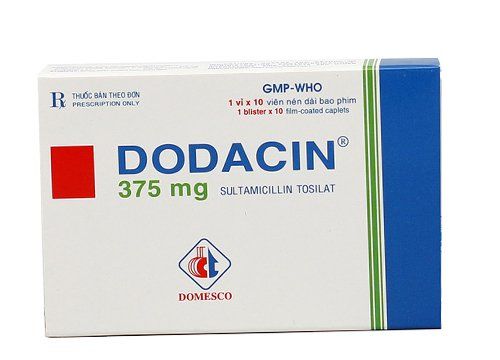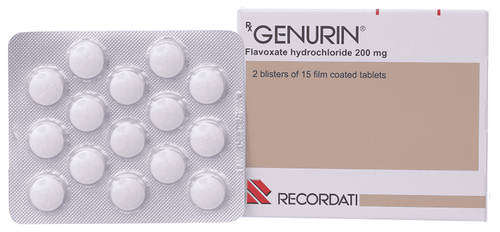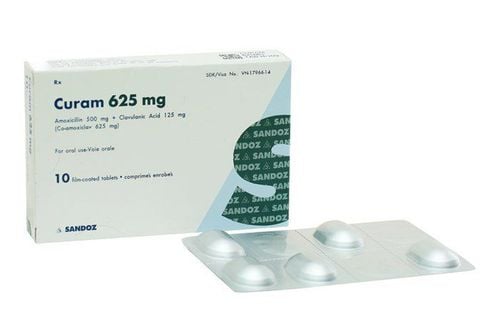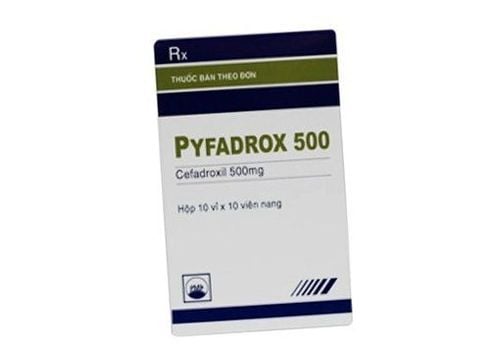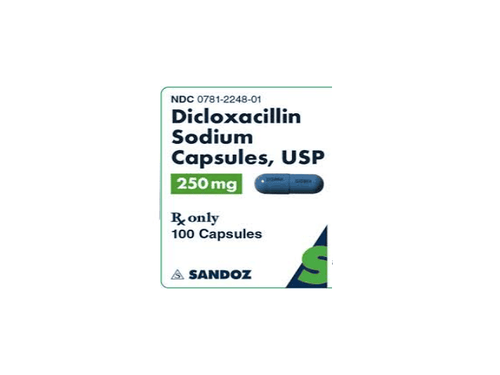This is an automatically translated article.
The active ingredient Clavuxel is Amoxicillin in combination with Clavulanic Acid. The drug is often indicated in the treatment of bacterial infections such as pneumonia, bronchitis, tonsillitis, otitis media, cystitis and pyelonephritis,...1. What is Clavuxel?
Clavuxel medicine contains Amoxicillin in the form of Amoxicillin trihydrate salt with a strength of 500mg and Clavulanic acid in the form of clavulanate sodium salt with a strength of 125mg. Amoxicillin in combination with Clavulanate enhances the bactericidal effect and expands the antibacterial spectrum. This combination does not affect the mechanism of action of Amoxicillin (inhibiting the synthesis of the peptidoglycan layer in the bacterial cell wall). Clavulanic acid has a beta-lactam structure similar to that of penicillin, has high affinity, and binds to bacterial beta-lactamases to inhibit the action of this enzyme. Clavulanic acid can penetrate the cell wall of bacteria, thereby inhibiting enzymes on the outside of the cell and enzymes attached to the cell. The way clavulanic acid works varies according to the enzyme being inhibited, but clavulanic acid usually acts as an irreversible competitor. The bactericidal spectrum of Clavuxel includes aerobic Gram-positive bacteria such as: Streptococcus faecalis, Streptococcus viridans, Streptococcus pneumoniae, Streptococcus pyogenes, Staphylococcus aureus, Bacillus anthracis...Gram-positive anaerobic including Clostridium, Peptococcus, Peptostreptococcus ... or Gram-negative aerobic bacteria include: Haemophilus influenzae, Escherichia coli, Proteus mirabilis, Moraxella catarrhalis, Proteus vulgaris, Klebsiella species, Salmonella, Neisseria meningitidis, Shigella, Neisseria gonorrhoeae, Vibrio cholerae... and also Gram-negative anaerobes such as: Bacteroides including B. fragilis. Thus, Amoxicillin and Clavulanate are effective against both bacteria that produce and do not produce beta-lactamases sensitive to the drug.
2. What are the effects of Clavuxel?
Clavuxel drug can be used in the treatment of the following conditions:
Upper respiratory tract infections including: otitis media, tonsillitis and sinusitis ... Lower respiratory tract infections include: Pneumonia, inflammation acute and chronic bronchi. Genitourinary tract infections caused by susceptible Beta-lactamase-producing strains of E. coli, Klebsiella and Enterobacter include cystitis, urethritis and pyelonephritis. Skin and soft tissue infections such as abscesses, wound infections and cellulitis. Bone and joint infections such as osteomyelitis. Dental infections such as alveolar abscesses. Other infections include miscarriage or intra-abdominal infections. Clavuxel is contraindicated in:
Patients allergic to Beta-lactams; Patients with hypersensitivity to any component of the drug or a history of jaundice, liver dysfunction related to Amoxicillin - Clavulanate.
3. Dosage and usage of Clavuxel
The dose of Clavuxel may vary depending on the disease and the patient's overall health. Below is a reference dose of Clavuxel:
For adults and children over 40 kg: It is recommended to take 1 tablet of 500 mg/125 mg every 12 hours. For severe infections and respiratory tract infections: The usual dose is 1 tablet of 500 mg/125 mg every 8 hours. If the patient has difficulty swallowing, an oral suspension may be used instead of the tablet. Elderly: No dose adjustment of Clavuxel is required unless the creatinine clearance is ≤ 30 ml/min. Patients with renal impairment: Mild renal impairment (CrCl > 30 ml/min) should be administered at a dose of 625 mg x 2 times/day or 1 g x 2 times/day; moderate renal impairment (CrCl 10 - 30 ml/min) the recommended dose is 625 mg x 2 times/day; Severe renal impairment (CrCl < 10 ml/min), do not exceed 625 mg every 24 hours. Dialysis patients: 625 mg orally every 24 hours is recommended, an additional 625 mg during dialysis, repeated at the end of dialysis. Patients with hepatic impairment: Use Clavuxel with caution, and periodically check liver function. 4. What are the side effects of Clavuxel? Patients using Clavuxel may experience side effects including:
Common:
Gastrointestinal: Diarrhea, nausea, vomiting. Nausea and vomiting are often related to the dose of clavulanic acid (250 mg clavulanic acid increased risk by 40% compared with 125 mg). Skin: Itching and rash Uncommon:
Blood: Eosinophilia; Liver: Hepatitis, cholestatic jaundice, increased transaminases; Nervous system: Dizziness, headache; Gastrointestinal tract: Indigestion; Skin and subcutaneous tissue: Rash, pruritus, urticaria; Other: Vaginitis, Candida, fever and fatigue. Rare:
Systemic: Anaphylaxis and Quincke's edema. Blood: Thrombocytopenia, leukopenia and hemolytic anemia. Digestive system: Pseudomembranous colitis Skin and soft tissue: Stevens - Johnson syndrome, atopic dermatitis, toxic epidermal necrolysis. Renal - urinary: Interstitial nephritis.
Renal - urinary: Interstitial nephritis. 5. Notes when using Clavuxel
Clavuxel should be used with caution in elderly patients, patients with a history of jaundice/hepatobiliary dysfunction because clavulanic acid may increase the risk of intrahepatic cholestasis. Signs of cholestatic jaundice are rare but can be severe. However, these symptoms are usually reversible after 6 weeks of stopping treatment. Patients receiving Clavuxel may experience serious hypersensitivity reactions, especially in patients with a history of allergy to penicillin or other allergens. Therefore, before initiating treatment, it is necessary to carefully investigate the history of allergy to penicillins, cephalosporins and other allergens. Patients with moderate or severe renal impairment should pay attention to adjusting the dose of Clavuxel. Convulsions may occur in patients with reduced renal function or in patients receiving high doses of Clavuxel. Like other antibiotics, prolonged use of Clavuxel sometimes leads to the development of resistant bacteria. Blood counts, liver and kidney function should be checked periodically during treatment with Clavuxel. Pseudomembranous colitis may occur in patients receiving the antibiotic Clvuxel and range in severity from mild to life-threatening. Therefore, the diagnosis should be considered in patients who develop diarrhea during or after Clavuxel administration. If diarrhea is severe, persistent, or abdominal cramping occurs, discontinue Clavuxel immediately. Pregnancy: Experimental studies in rats have shown that oral and injectable doses greater than 10 times the human dose do not cause malformations. However, Clavuxel should still be used with caution and consult a specialist before using it in pregnant women. Lactation: During lactation, Clavuxel can be used. Clavuxel is not harmful to nursing infants, but there is a risk of sensitization due to very small amounts of the drug in breast milk. 6. Drug interactions Using Clavuxel with some other drugs can cause interactions and affect the effectiveness of treatment. Therefore, patients need to inform their doctor or pharmacist of all medicines and supplements they are taking for advice. The following are some interactions to note when using Clavuxel:
Interactions with some gout medications such as Probenecid, Allopurinol. Patients with hyperuricemia when taking Alopurinol with the antibiotic Amoxicillin will increase the likelihood of rash of Amoxicillin. Clavuxel may affect the effectiveness of oral contraceptives; Clavuxel may increase the effectiveness of anticoagulants such as Acenocoumarol, Warfarin Clavuxel may reduce the excretion of Methotrexate and lead to increased toxicity Here is the complete information about Clavuxel, patients should read the directions carefully. Instructions for use, consult your doctor / pharmacist before use. Note, Clavuxel is a prescription drug, patients absolutely must not buy and treat at home because they may experience unwanted side effects.




